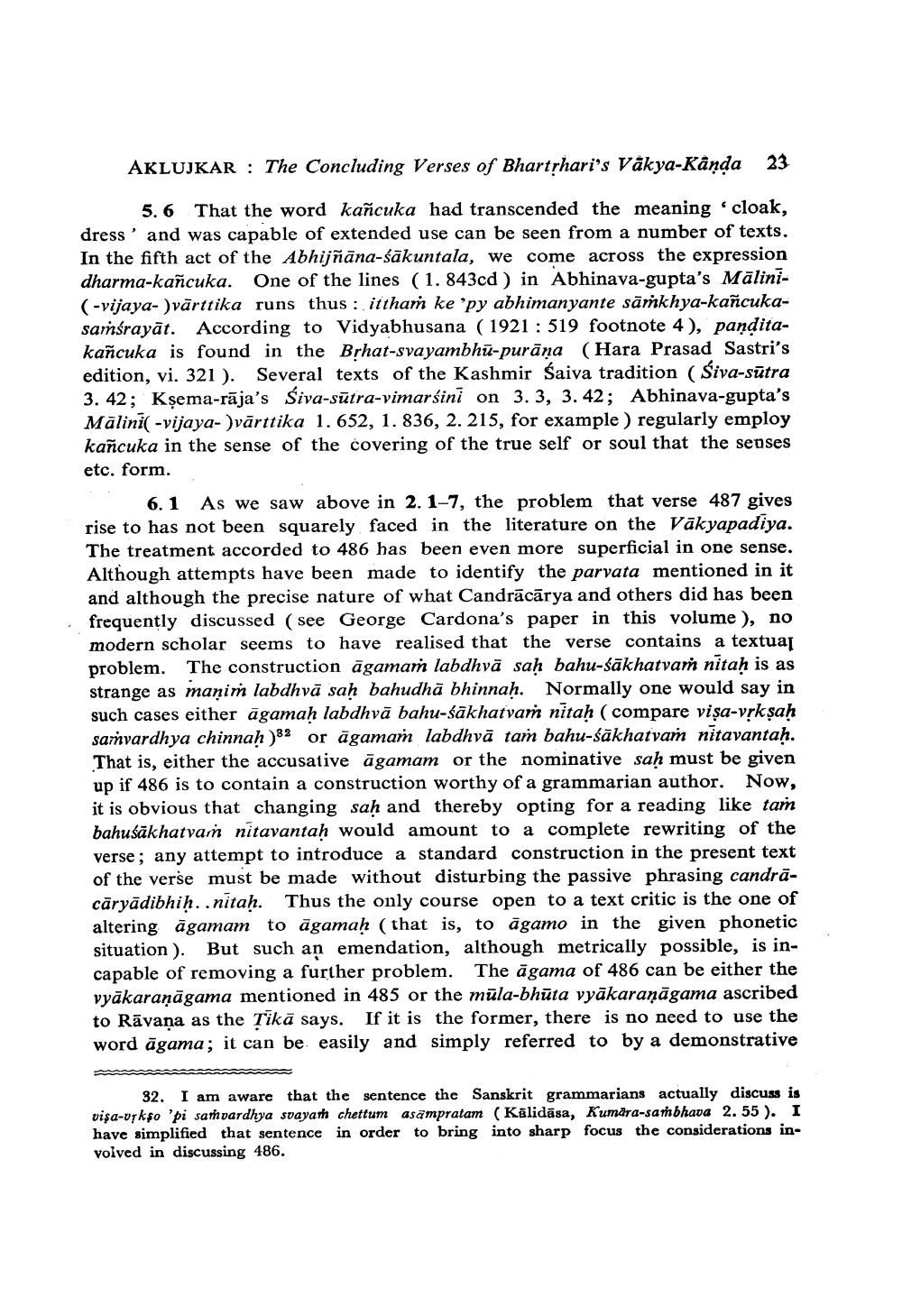________________
AKLUJKAR : The Concluding Verses of Bhartrhari's Väkya-Kānda 23
5.6 That the word kañcuka had transcended the meaning cloak, dress' and was capable of extended use can be seen from a number of texts. In the fifth act of the Abhijñāna-śākuntala, we come across the expression dharma-kañcuka. One of the lines (1. 843cd ) in Abhinava-gupta's Mālini(-vijaya- ) vārttika runs thus : itthaṁ ke 'py abhimanyante sāṁkhya-kañcukasamśrayāt. According to Vidyabhusana ( 1921 : 519 footnote 4), panditakañcuka is found in the Brhat-svayambhū-purāņa (Hara Prasad Sastri's edition, vi. 321). Several texts of the Kashmir Saiva tradition (Siva-sūtra 3. 42; Kșema-rāja's Śiva-sūtra-vimarsini on 3.3, 3.42; Abhinava-gupta's Mālinis -vijaya- )vārttika 1.652, 1. 836, 2.215, for example ) regularly employ kañcuka in the sense of the covering of the true self or soul that the senses etc. form.
6.1 As we saw above in 2.1-7, the problem that verse 487 gives rise to has not been squarely faced in the literature on the Vākyapadiya. The treatment accorded to 486 has been even more superficial in one sense. Although attempts have been made to identify the parvata mentioned in it and although the precise nature of what Candrācārya and others did has been frequently discussed (see George Cardona's paper in this volume ), no modern scholar seems to have realised that the verse contains a textuaj problem. The construction āgamaṁ labdhvā sah bahu-śākhatvaṁ nitah is as strange as maņiṁ labdhvā sah bahudhā bhinnah. Normally one would say in such cases either agamaḥ labdhvā bahu-śākhatvam nitah (compare vişa-vrkṣaḥ sarvardhya chinnah )32 or āgama labdhvă tar bahu-śākhatva nitavantaḥ. That is, either the accusative āgamam or the nominative sah must be given up if 486 is to contain a construction worthy of a grammarian author. Now, it is obvious that changing saḥ and thereby opting for a reading like tam bahuśākhatvam nitavantah would amount to a complete rewriting of the verse; any attempt to introduce a standard construction in the present text of the verse must be made without disturbing the passive phrasing candracāryādibhiḥ..nitaḥ. Thus the only course open to a text critic is the one of altering agamam to āgamah (that is, to āgamo in the given phonetic situation ). But such an emendation, although metrically possible, is incapable of removing a further problem. The ägama of 486 can be either the vyākaraṇāgama mentioned in 485 or the mūla-bhūta vyākaraṇāgama ascribed to Rāvaņa as the Tikā says. If it is the former, there is no need to use the word āgama; it can be easily and simply referred to by a demonstrative
32. I am aware that the sentence the Sanskrit grammarians actually discuss is visa-vīkso 'pi samvardhya svayath chettum asampratam (Kālidāsa, Kumāra-sambhava 2. 55). I have simplified that sentence in order to bring into sharp focus the considerations involved in discussing 486.




